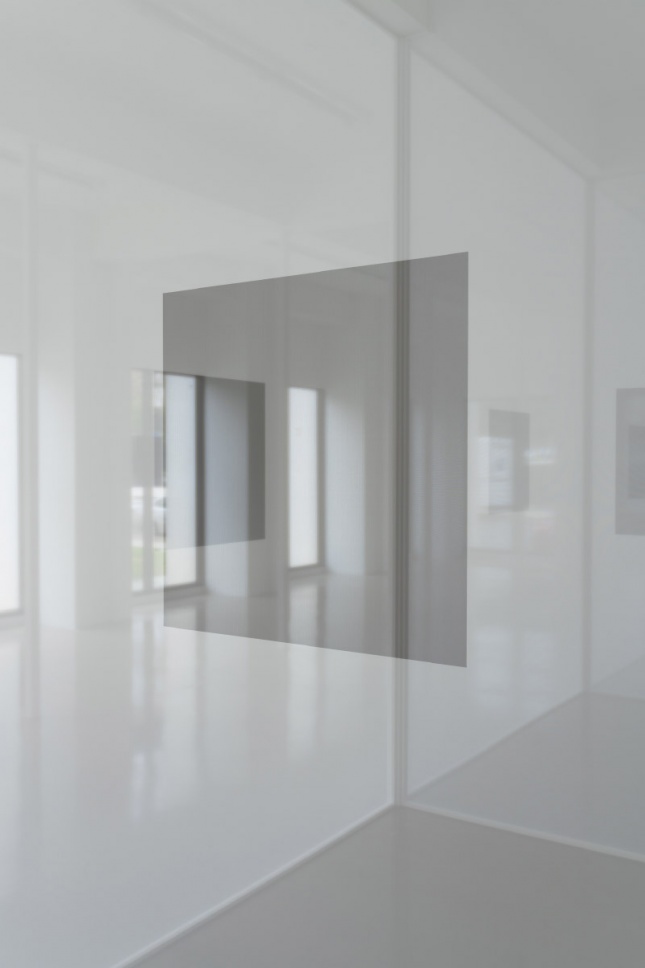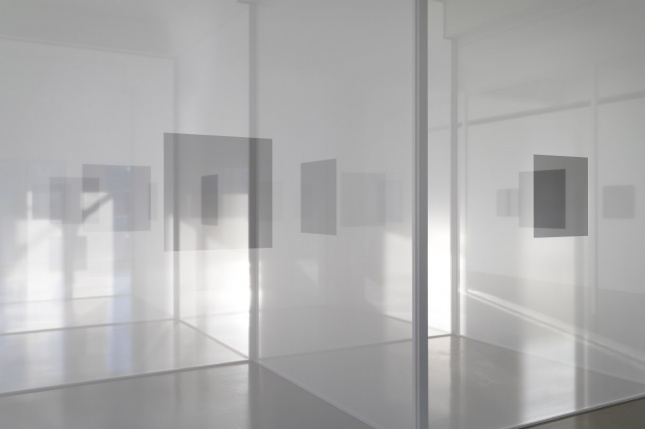Robert Irwin
Sprüth Magers, Los Angeles
January 23–April 21, 2018
In Robert Irwin’s words, a scrim “is both there and it’s not,” a status that could just as easily describe the effects of history. His site-specific exhibition at Sprüth Magers in Los Angeles, which occupies two floors of the gallery, seems to resonate with L.A.’s history, not in the least because it so vigorously attempts a dialogue with both the exterior street and the interior structure. On the first floor, the windows facing Wilshire Boulevard are left unobscured, providing glimpses of passing buses, pedestrians, and William Pereira’s facade of the Los Angeles County Museum of Art as veiled by the semitransparent sheen of the scrims. In contrast, the second floor features opaque interior walls that block out most of the exterior light, but are interrupted at the corners so that a viewer can walk behind the walls and stand in a purposefully awkward nook next to one of the building’s original windows. On the first floor, the visitor is made aware of the act of perception, while on the second floor the inevitable limitations of one’s perception become evident.

The exhibition, which was on view through April 21, was designed by Robert Irwin for this specific, 5,000-square-foot space. Because the work is so intertwined with the building, it’s difficult not to describe the work in terms of decor. This is especially pronounced on the second floor, which features banks of neon tubes that seem to be oversize dispatches from a partial DNA sample. Space is occasionally left between the mounted tubes, creating the impression of absence within the bank. However, installed above the neon tubes in the ceiling are inactive fluorescent lights, which seem to hint at the inevitability of mortality. One may begin life as a vivid neon tube, but eventually, the light goes out.

The darker interior, which is bisected by a black rectangular scrim, amplifies this feeling of absence: The room appears to be the remainder of something, not its origin point. The fact that the viewer is designed to encounter the second floor after the first makes the former both potentially a dramatic ending and a second act; depending on how long one lingers on the first floor after walking down the stairs, the second floor can become a referendum on how we choose to perceive. Once we’ve seen what’s out there, do we ultimately open our perceptions up to the outside world, or do we end up ensconced in our own darkened, incomplete rooms?
Back on the first floor, a series of square black-lacquered panels are placed along the wall opposite the scrims. If a viewer walks around the installation, these panels visually align with the black squares on the scrim to create undulating tunnels of fabric and air. What was formerly indistinct and wispy suddenly becomes solid and intense. It is the architectural expression of realization, a tangible eureka moment. Walk a little farther on, however, and the squares once again fall out of alignment, becoming just shadows in the void.
The exhibition can only be viewed during daylight hours, which lends it a certain poignancy, but not urgency. Much like Los Angeles itself, the materials involved and the ample amount of space in which to view them promotes a relatively serene atmosphere. There’s not a sense of hurry, but there is a sense of finitude. This is not an experience that can be repeated in some other room, at some other time. It is designed to root the viewer in that particular moment, and what a moment it is: The relative lack of ornament amplifies both the sleepy midday traffic outside and whatever feelings and thoughts preoccupy the viewer, which on a Wednesday afternoon in April 2018 in the United States are variegated, to say the least. Much like the scrims, the presence of history is both there and not there, subtly framing everything we see.
Julia Ingalls is primarily an essayist who lives in Los Angeles.













